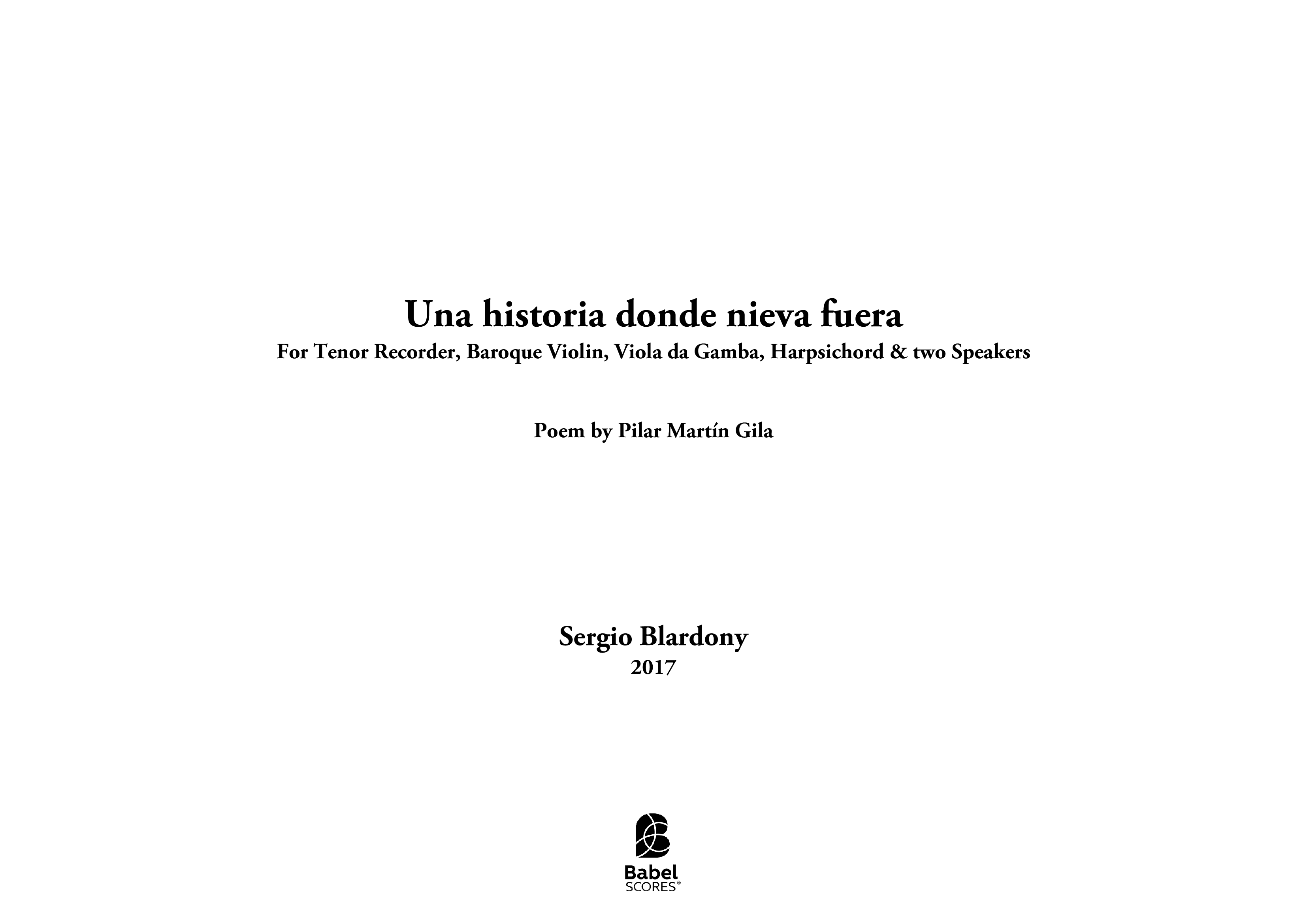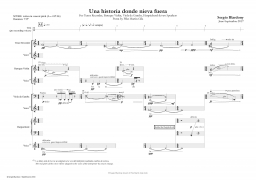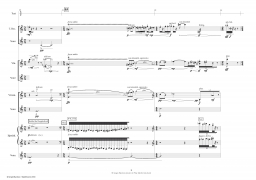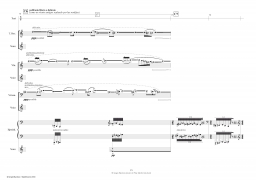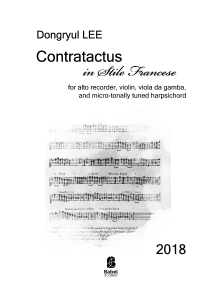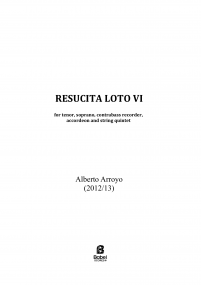Una historia donde nieva fuera
About a poem by Pilar Martín Gila
9,27 €
Printed format (+14,80 € printing and shipping). Colissimo7-14 days aprox.
Digital version (+0,00 €) instant download
When you buy a score, you can contact the composer right here!
Specifications
Region
Europe
Estimated Duration
6 - 10min
Date
2017
ISMN : 979-0-2325-3443-5
Videos on this piece
Notes on this piece
[ENGLISH]
There is no certainty whatsoever in this tense investigation between music and the poetic word that I have spent over a decade on and which, fortunately, I see more clearly each time. Una historia donde nieva fuera (A story where it snows outside) is, perhaps, the work where all the components of the structural plane are closest to the text. Nonetheless, paradoxically, it is also the piece in which tension about the preconceived is strongest –that structural combination which emerges from the text with conviction, and is represented in numbers- and the enigma of the unexpected, of the rupture from the established plan. For this reason, I could say that it is one of those works where the poetic –in a wide sense of the term- takes on the principal role, where the handling of that uncertainty between the exact and the perilous takes place with much less inhibition (rather than security), entrusting the actual poem, its constant reading and its internalisation, to whoever –will ultimately- conduct the voice and the musical flow.
On the other hand, the proposed work I have with Continuum XXI supposes a handicap which is none too easy to resolve: working with period instruments makes me question what meaning the use of an instrument could have in accordance with an extended concept of technique. To provide a clear example, what can differentiate the tonlos of a viola da gamba from that of a cello? From questions such as these was born the need to find an internal sound which, in some way, alludes to the historical time of the instruments. I say “internal sound” and I could say –probably in a more correct way- “internal resonance”, because my intention is that the old moves into a more precisely un-historical (at least un-referential) plane, in a way that listening to it will engender an ancient source without requiring the evidence (for example, the encounter would be very clear evidence). In short, that in terms of listening to the work, one can sense a trace of the old in one’s most immediate memory. This has been one of the fundamental challenges that this work has given me.
The work takes on a unifying thread through the following poem from the book La Cerillera by Pilar Martín Gila.
[SPANISH]
En esta tensión indagatoria entre música y palabra poética que me ocupa desde ya hace más de una década y en la que, afortunadamente, cada vez veo más claro no existe certidumbre alguna, Una historia donde nieva fuera es quizá la obra donde todos los componentes del plano estructural están más pegados al texto. Sin embargo, paradójicamente, es también la pieza donde toma más fuerza la tensión entre lo preconcebido –ese conjunto estructural que emana con seguridad del texto, metaforizado en número- y el enigma de lo inesperado, de la ruptura con el plan trazado. Por esta razón podría decir que es una de las obras donde lo poético –en un amplio sentido del término- toma un relieve mayor, donde el manejo de esa incertidumbre entre lo exacto y lo azaroso se hace con una mayor desinhibición (que no seguridad), confiando en que sea el propio poema, en su constante lectura e interiorización, el que conduzca –en último término- el flujo sonoro y musical.
Por otro lado, la propuesta de trabajo que me hace Continuum XXI supone un hándicap nada sencillo de resolver: el trabajo con instrumentos de época me sugería la pregunta sobre qué sentido podría tener un uso instrumental acorde con un concepto extendido de la técnica. Por poner un ejemplo muy claro, ¿qué puede diferenciar un sonido tonlos en una viola da gamba del de un violoncello? De cuestiones como estas nació la necesidad de encontrar un sonido interior que aludiese, de algún modo, al tiempo histórico de los instrumentos. Y digo “sonido interior” y podría decir –seguramente de manera mucho más acertada- “resonancia interior”, porque lo que pretendo es que lo antiguo se traslade a un plano precisamente no histórico (al menos no referencial), de forma que la escucha provoque un devenir antiguo sin apelar a la evidencia (la cita sería, por ejemplo, una evidencia muy clara). En definitiva, que al término de la escucha de la obra se pueda percibir, en la memoria más inmediata, una huella sonora de lo antiguo. Este ha sido uno de los retos esenciales que me ha planteado esta pieza.
La obra toma como hilo conductor el siguiente poema del libro La cerillera de Pilar Martín Gila.
Add to a playlist
- Login to create your own lists
There is no certainty whatsoever in this tense investigation between music and the poetic word that I have spent over a decade on and which, fortunately, I see more clearly each time. Una historia donde nieva fuera (A story where it snows outside) is, perhaps, the work where all the components of the structural plane are closest to the text. Nonetheless, paradoxically, it is also the piece in which tension about the preconceived is strongest –that structural combination which emerges from the text with conviction, and is represented in numbers- and the enigma of the unexpected, of the rupture from the established plan. For this reason, I could say that it is one of those works where the poetic –in a wide sense of the term- takes on the principal role, where the handling of that uncertainty between the exact and the perilous takes place with much less inhibition (rather than security), entrusting the actual poem, its constant reading and its internalisation, to whoever –will ultimately- conduct the voice and the musical flow.
On the other hand, the proposed work I have with Continuum XXI supposes a handicap which is none too easy to resolve: working with period instruments makes me question what meaning the use of an instrument could have in accordance with an extended concept of technique. To provide a clear example, what can differentiate the tonlos of a viola da gamba from that of a cello? From questions such as these was born the need to find an internal sound which, in some way, alludes to the historical time of the instruments. I say “internal sound” and I could say –probably in a more correct way- “internal resonance”, because my intention is that the old moves into a more precisely un-historical (at least un-referential) plane, in a way that listening to it will engender an ancient source without requiring the evidence (for example, the encounter would be very clear evidence). In short, that in terms of listening to the work, one can sense a trace of the old in one’s most immediate memory. This has been one of the fundamental challenges that this work has given me.
The work takes on a unifying thread through the following poem from the book La Cerillera by Pilar Martín Gila.
[SPANISH]
En esta tensión indagatoria entre música y palabra poética que me ocupa desde ya hace más de una década y en la que, afortunadamente, cada vez veo más claro no existe certidumbre alguna, Una historia donde nieva fuera es quizá la obra donde todos los componentes del plano estructural están más pegados al texto. Sin embargo, paradójicamente, es también la pieza donde toma más fuerza la tensión entre lo preconcebido –ese conjunto estructural que emana con seguridad del texto, metaforizado en número- y el enigma de lo inesperado, de la ruptura con el plan trazado. Por esta razón podría decir que es una de las obras donde lo poético –en un amplio sentido del término- toma un relieve mayor, donde el manejo de esa incertidumbre entre lo exacto y lo azaroso se hace con una mayor desinhibición (que no seguridad), confiando en que sea el propio poema, en su constante lectura e interiorización, el que conduzca –en último término- el flujo sonoro y musical.
Por otro lado, la propuesta de trabajo que me hace Continuum XXI supone un hándicap nada sencillo de resolver: el trabajo con instrumentos de época me sugería la pregunta sobre qué sentido podría tener un uso instrumental acorde con un concepto extendido de la técnica. Por poner un ejemplo muy claro, ¿qué puede diferenciar un sonido tonlos en una viola da gamba del de un violoncello? De cuestiones como estas nació la necesidad de encontrar un sonido interior que aludiese, de algún modo, al tiempo histórico de los instrumentos. Y digo “sonido interior” y podría decir –seguramente de manera mucho más acertada- “resonancia interior”, porque lo que pretendo es que lo antiguo se traslade a un plano precisamente no histórico (al menos no referencial), de forma que la escucha provoque un devenir antiguo sin apelar a la evidencia (la cita sería, por ejemplo, una evidencia muy clara). En definitiva, que al término de la escucha de la obra se pueda percibir, en la memoria más inmediata, una huella sonora de lo antiguo. Este ha sido uno de los retos esenciales que me ha planteado esta pieza.
La obra toma como hilo conductor el siguiente poema del libro La cerillera de Pilar Martín Gila.
Instrumentation
Harpsichord|Violin|Viola da gamba|Recorder|Harpsichord
Score Details
Format - A3 / Tabloid
Pages - 28
Pages - 28

